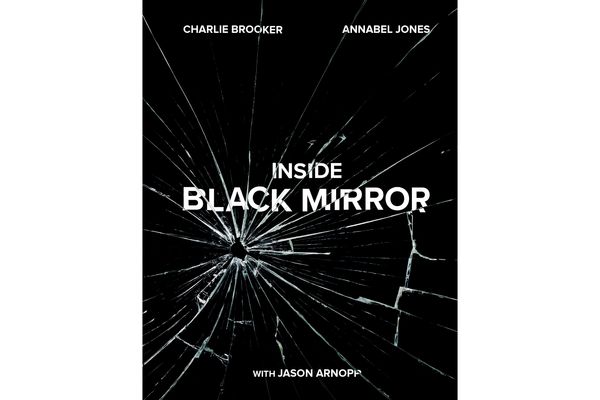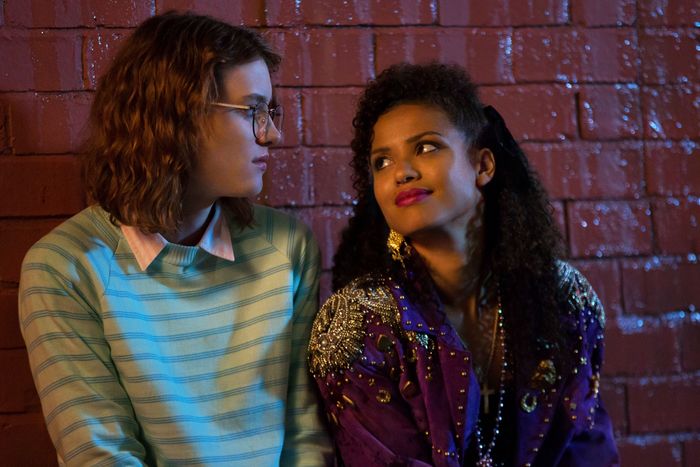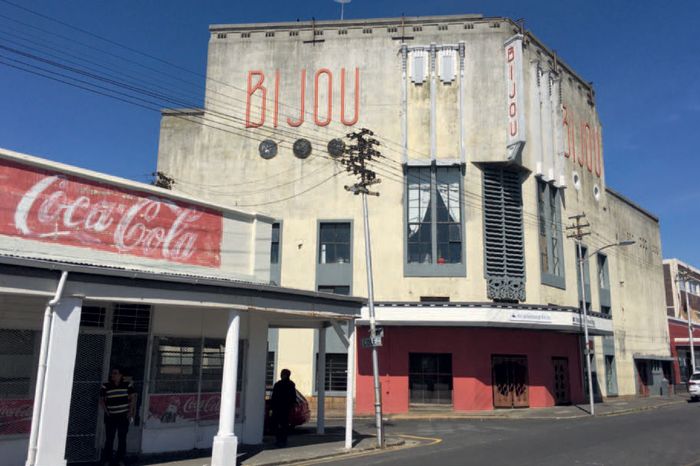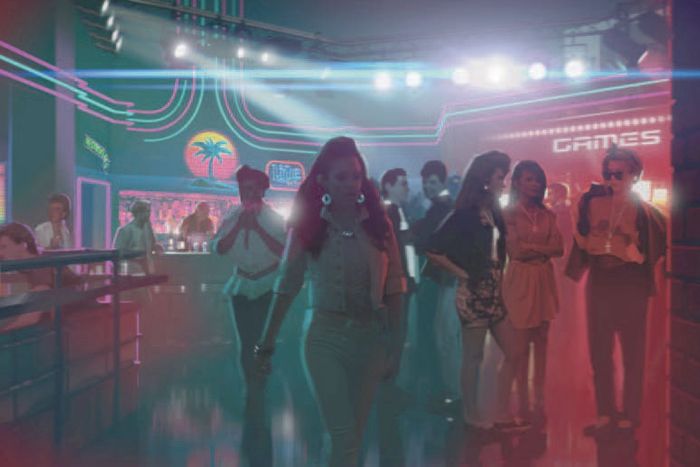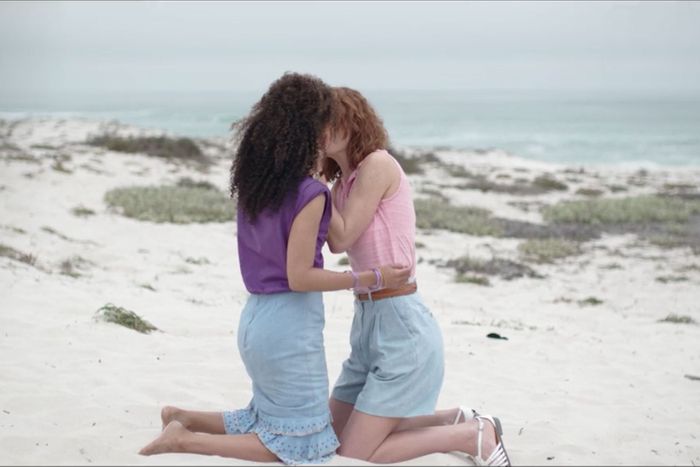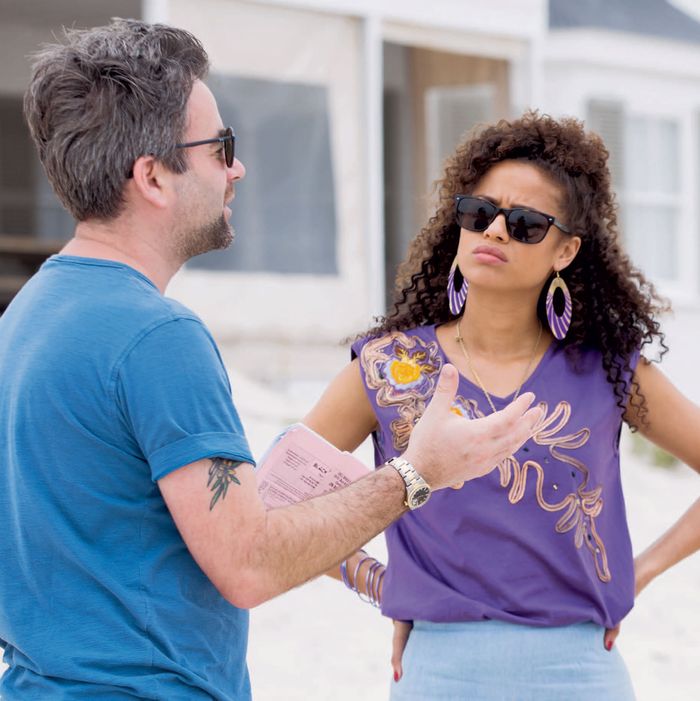
In 1987, self-conscious Yorkie meets flamboyant Kelly in a beach resort bar. The two women fall for each other, but there’s more to the sparkling paradise of San Junipero than meets the eye. As the time nears for Kelly to leave town, she faces a huge decision.
Charlie Brooker (writer, Black Mirror creator): I’d been obsessed with doing a story about the afterlife. I wanted to do a sort of supernatural story, and was thinking of spooky, creepy story ideas. So, weirdly, “San Junipero” had started in a sort of horror-movie world.
Annabel Jones (executive producer): We always have a scientific explanation for things, even if it’s bollocks! We introduced the idea of digital consciousness in “White Christmas,” but hadn’t really explored the moral or emotional implications. There was so much untapped potential.
Charlie Brooker: Something else that we’d discussed was a way of expanding the world of “Be Right Back.” We couldn’t do this now because of Westworld, but we had the idea of a theme park you went to that was essentially Heaven. All your dead relatives and friends would be there, and you’d pay to go and visit them. So that thought stayed around for a while — this notion of Heaven that you go to as a holiday.
Sometimes it’s useful to start by thinking about what genres we haven’t done yet. Partly because we were doing six films now, we wondered about a retro episode. How could we do one set in the past? And then I’d remembered seeing this BBC documentary called The Young Ones — no relation to the sitcom — back in 2010. They’d taken six aging celebrities, in their 70s and 80s, and put them in a house decorated like the 1970s, with vintage TV shows playing on the TV and everything, and the results were astonishing. They were suddenly full of life, almost tossing their walking sticks away, like they were 20 years younger.
So you can see how all these ideas lined up. At some point, they were all up on a whiteboard somewhere. The conversation became quite free-flowing as we bounced from one idea to another. And then it happened really quickly: I was talking to Annabel, going, “Ooh! Ooh! And then this would happen and that would happen!” And she almost burst into tears.
Annabel Jones: Because it was so sad. Such an emotional story.
Charlie Brooker: Back then, our characters were a man and a woman. The big twist was one of them was in a coma or dying. That was where it ended.
Annabel Jones: Once you start exploring the world, and the capabilities it offers up, you wonder what else that world might give someone that they may not have had before. Then came that idea of having a life unfulfilled, because you’ve been in a coma for 40 years, and going back to a time when maybe you couldn’t have been as sexually free as you could today.
Charlie Brooker: At some point, the thought arrived of making this a same-sex couple. Rather than that feeling like a gimmick, it became both relevant and irrelevant to the story. It informed a whole other layer because these people couldn’t have got married as two women in 1987.
Annabel Jones: I also love that this is a story about two mature women, finding each other and falling in love. And you forget that they’re old. It’s a cliché, but when you’re old you’re still mentally and emotionally alive to all experiences. It’s just your body that’s letting you down. And so, to be free of that and go and fuck as much as they want, and drink as much as they want … why wouldn’t these two mature women want to be doing this? But you don’t think of virtual reality as empowering the old. So it was just such a great fusion of ideas, all coming together in an emotionally satisfying way.
Charlie Brooker: I thought people would find it more shocking or surprising, that old people had been talking to each other about fucking, but no one ever comments on it. People just accept it, which is refreshing. As usual, I was worried, because I hadn’t really written a love story before. I was really worried that people would think it was absurd how quickly Kelly and Yorkie fall for each other. So I had to fight a voice in my head that said, “It wouldn’t happen like that — they’ve literally met for ten minutes.”
“San Junipero” saw director Owen Harris return to the Black Mirror fold, having handled season two’s “Be Right Back.”
Joel Collins (series production designer): When Owen came into the office, I showed him all the visual work I’d done to express what “San Junipero” could be, and he loved it. We looked at things like Pretty in Pink and Ferris Bueller’s Day Off. Once again, the goal was to settle the audience into a place they know, and give them a stereotype that they can enjoy.
Owen Harris (director): Bizarrely, in the end, it was the ’80s setting that excited me. If you look back to a lot of films from that decade — in particular those films written or directed by John Hughes — the mood was far more optimistic, almost to the point where you could classify it as a genre. The genre of eternal optimism! Black Mirror comes from a background of satire, which is by nature somewhat cynical, and that’s why I liked the idea of adopting a positive genre to tell one of these tales.
The key choice was the casting of Gugu and Mackenzie. This would have been a far trickier piece to pull off without their thoughtful and confident approach. As soon as we attached them, I really felt we had the chance to make something special.
Gugu Mbatha-Raw (actor): Black Mirror has always been such a dark, interesting and cool show. I loved “Be Right Back.” It reminded me of [the Roald Dahl ’80s anthology TV show] Tales of the Unexpected.
Mackenzie Davis (actor): When my friends and I watched the first-ever episode — “the pig fucking one” as it is colloquially known — we just sat in awe at what we were seeing. It felt like the first time I saw Twin Peaks, where the rules and expectations of what a television show was and could be were exploded. When I ended up getting the offer to be a part of the show, it felt like a Twilight Zone scenario, where you step through your screen and enter the world you never thought you would participate in, beyond your own passive viewing. It was surreal.
Gugu Mbatha-Raw: I first read “San Junipero” on my iPhone — an act which felt very Black Mirror–esque in itself. It was so original, it blew me away. I was so drawn into the vivacity of Kelly, and the whole idea of the ’80s soundtrack, which was already written into the script. Something about it was very inspiring and unusual.
Mackenzie Davis: Charlie wrote Yorkie as an exquisitely brave character in such a quiet and unusual way. When we first meet her, she seems like a shy dork with some strange mannerisms, but the more you learn about her, the more it is revealed how her dress, behavior, and mere presence in this world is an act of brutal honesty, bravery, and authenticity. She is one of two or three characters I feel the luckiest to have been able to be a part of.
Gugu Mbatha-Raw: I first met Mackenzie at breakfast at the Charlotte Street Hotel, with Owen and our producer Laurie Borg. We had a chat, then did the table read. It was a real whirlwind, so I didn’t have much time with Mackenzie beforehand. Thankfully, the characters were so well-written and Mackenzie’s a brilliant actress.
Mackenzie Davis: Gugu and I first met in the hotel elevator. We were riding the elevator, ignoring each other, as you do, then I looked in the mirror at Gugu and realized she was my love Kelly! From then on, we just adored each other, and I’m so thankful she was my partner throughout this whole experience.
From the era-specific fashion to the ’80s nightclub where Yorkie and Kelly meet, costume and production design for “San Junipero” required a meticulous eye for detail.
Laurie Borg (producer): Our biggest challenge was creating period America on a tight budget, so the key decision I made was to film most of the interiors in London and most of the exteriors in Cape Town. I knew we could not afford to film in the U.S., but also knew South Africa could deliver “period” Americana streets and coastlines.
Annabel Jones: On the first day of filming for our new big Netflix Black Mirror series, we shot the interior scenes of the Quagmire. A dodgy club in North London. Naked butts, nipple tassels, and pierced bits everywhere. We knew how to spend those Netflix dollars.
Joel Collins: Before we built Tucker’s Bar for real, we built it in 3-D. I gave Charlie and Owen a VR headset, so they could walk around the bar and and look at the space. In the industry that process is just beginning, so we marched ahead a bit. We were Black Mirror, after all.
Owen Harris: You could walk around this VR bar and say things like, “Can we push the bar back a bit? Can we make the balcony a bit wider?” My overriding memory is feeling a bit seasick every time I put it on, so I gave up, but it was incredibly useful, and I massively appreciated the effort.
Susie Coulthard (costume designer): San Junipero needed to feel like a simulated world without being too obvious. We discussed only having one outfit for Kelly and Yorkie in 1987, but decided it was better to have a narrative within the wardrobe, as if you could make those choices when accessing the San Junipero system. The wedding dresses, both made from the same fabric but differing ’80s styles, suggested you could design your own wedding look within the system.
Tanya Lodge (hair and makeup): I wanted to tell Kelly and Yorkie’s story by giving them a strong look that defined their personality but felt believable for the audience. Kelly’s flamboyant appearance was a collaboration between costume and makeup. The big hair was inspired by style icons of the time such as Janet Jackson, Whitney Houston, and Lisa Bonet. Her bold lipstick choice showed her confidence and ease with herself. In contrast, the pared-back look of Yorkie hinted at her innocence and social unease.
Susie Coulthard: Gugu and I kept coming back to a purple suede Versace jacket I had found on Brick Lane. We worked out that we needed to razz it up with studs and fringe to make it more Kelly.
Mackenzie Davis: I loved the very first Yorkie outfit: the pleated khaki shorts and aqua sweater over a pink polo. It still makes me laugh that she could have put together anything for this new self and she chose something that looks like her mom laid it out on her bed the night before a charity golf tournament! But it was authentically her, and there’s something so beautiful about this woman choosing to be authentically herself in this moment of unlimited possibility. The thrill of her identity and her queerness is the event, the reason for all of this, not the opportunity to reinvent her exterior self and sell a coolness that would appeal to anyone else.
Susie Coulthard: With Yorkie’s glasses, I really wanted the changes to be slight yet period-authentic as she jumped around the years. When she finally enters the system as a full-timer, she has no glasses, as San Junipero has become her authentic life. Owen suggested that she takes them off and leaves them on the beach, which I think is such a perfect moment.
Mackenzie Davis: I think they nicely undid the “transforming geek” trope by playing with the outfit montage early on. Were they loyal to that trope, Yorkie would have reentered Tucker’s in slow-mo, modelling the “Addicted to Love” look, and the whole bar would have gone slack-jawed and silent. Instead they played through all the transformative possibilities in the mirror and Yorkie settles, once again, on a golf-mom look and lets the transformation be self-motivated and internal. Quietly, it’s the most unique, least derivative of all the looks she tried on.
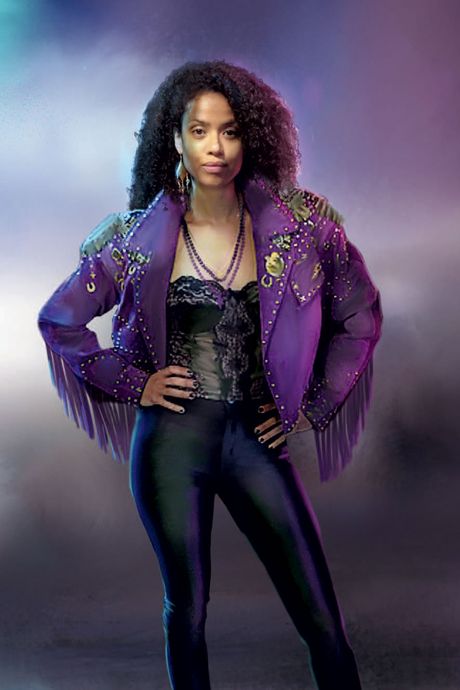
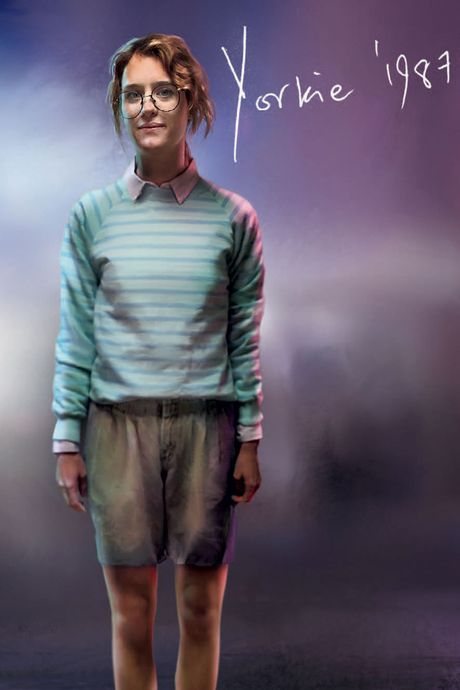
Tanya Lodge: As the two characters traveled through the decades, I kept one look for each period, so each year had an identifiable look, using various hair pieces and makeup. I particularly enjoyed creating the debauched world of the Quagmire, where we used crazy wigs and really strong makeup styles, letting our imagination run wild.
Annabel Jones: The concept allowed us to do Black Mirror’s version of time travel. When Yorkie goes searching for Kelly, she looks in lots of different years, so we had a lot of fun changing their costumes, the cars, the style of dancing. Charlie is incredibly specific, right down to the video games and arcade machines for every year. We spent a long time in postproduction looking at archive footage and posters that would help establish these different periods as quickly as possible — the footage that is playing in the TV shop, the film posters outside Tucker’s, the music.
Gugu Mbatha-Raw: We worked with a dance choreographer and played around with some very specific styles. We looked at the music videos of Janet Jackson. I don’t think they got the rights to her song “What Have You Done for Me Lately,” but that’s what we originally worked with and shot.
Charlie Brooker: Alexander O’Neal’s song “Fake” actually ended up being more fitting because “What Have You Done for Me Lately” had nothing to do with the story. Whereas with “Fake,” they were in an artificial world, so it had this additional layer. And luckily the song had exactly the same tempo, so their dance moves would still match.
Gugu Mbatha-Raw: We had so much fun! Kelly’s shoulder pads, and that rhythmic shoulder thing, were totally stolen from Janet. In terms of style, I definitely took inspiration from other artists like Prince and Whitney Houston. For me, it was a great chance to be goofy and expressive. I’d come off some quite intense movie roles, so it was nice to do something playful and not take it all so seriously. The dancing was a big part of that: It was all about expressing and celebrating Kelly’s life.
Mackenzie Davis: I was instructed to try to follow along with Gugu’s amazing Janet Jackson homage and fail awkwardly … which I did with ease!
Halfway through “San Junipero,” a throwaway comment from Kelly’s fling Wes suggests that all is not as it appears in the tropical playground. Brooker worked hard to ensure the film’s secrets gradually unveiled themselves.
Charlie Brooker: Writing a script like that is like being forced to come up with dialogue that rhymes because it’s got to do two different things at once. It’s got to sound like two people talking, like they might in an ’80s movie nightclub scene, but it’s also got to make sense as stuff that old people in a simulation might say and do. So instead of wondering what to do next, you have a constant little problem to solve. I had to get these two women to meet and fall in love, while constantly distracting the viewer from this thing in the corner of the room.
Annabel Jones: In the edit, we primed ourselves to wonder whether any line of dialogue might give too much away. Did it nod too much to the fact that these are 70-year-old women? And at the same time, you’re trying to intrigue by adding little clues.
Charlie Brooker: I thought we gave some huge clues, but people generally didn’t pick up on them! There’s a moment in Tucker’s when the guy shows Yorkie this arcade driving game, and a car crashes on the screen. She has this horrible visceral reaction because it reminds her of the car crash that paralyzed her. Once you know what’s going on, it makes perfect sense. We even put the noise of a car crash on the soundtrack, so I thought people would immediately go, “Oh, she’s been in a car crash in real life.” But no one ever picks up on it, until maybe a third viewing.
The other big clue was playing the Smiths’ “Girlfriend in a Coma” over a shot of Yorkie. You see, I seem to think that viewers are writing all these small details down! But they’re not. People only notice when a plot doesn’t make sense. It’s good to give the audience a chance to get it, though, because otherwise it might feel like a complete cheat.
In 1996, Yorkie is seen standing near an arcade game called Time Crisis. That was my little video-game joke because at that point you think they’re traveling through time. There’s also House of the Dead further into the future. Of course, a “house of the dead” is essentially what “San Junipero” itself is.
Toward the end of “San Junipero,” we finally discover that Kelly and Yorkie are elderly, dying women. The Kelly who visits Yorkie in the hospital is played by a different actress, Denise Burse.
Charlie Brooker: Denise was brilliant. It’s funny, sometimes I almost forget that there are two people playing Kelly, because when Denise shows up as “Elder Kelly,” as it said in the script, there’s a through-line that you weirdly just accept. People have even asked if Denise is Gugu in prosthetic makeup, because we were so fortunate with the casting.
Gugu Mbatha-Raw: When I first met Owen and Charlie, I said, “So, what’s the deal? Do I get to play it all? Am I gonna get some amazing prosthetics?” But Denise is so incredible. I’m glad it was done that way, because given what San Junipero is, it’s not as if you have to look like the same person.
Annabel Jones: We only discussed old-age makeup briefly, before ruling it out. You’ve got to at least have the discussion, but I think that stuff just always looks fake and throws you out of the moment.
Owen Harris: We went through the usual motions of looking for an older Gugu. Something about Denise and her choices as an actress — and also a Skype conversation where we just hit it off — made her feel right.
Gugu Mbatha-Raw: I had never met Denise, so Owen set a bit of an exercise for us where we would read each other’s lines. Not to imitate, or really do anything very technical — it was more to just listen to each other and spend time together.
Owen Harris: I would love to say that we were totally instrumental in making the change from young to old feel so seamless, but a lot of it was down to the simple fact that both actresses made the part so compelling.
Brooker’s original story line had climaxed when Elder Kelly visited Yorkie in the hospital.
Charlie Brooker: This was supposed to be the big emotional end: Kelly going in, kissing Yorkie on the forehead and saying, “Hello, stupid, it’s good to see you.” I thought that was a sweet, tear-jerking ending — two dying old ladies who’d found love — but I was enjoying the writing, so I thought I’d just keep going. And while working out what should happen next, I thought, Wait … what if, rather than dying, Yorkie’s going to be euthanized and live on in San Junipero? It added a whole extra, deeper level. So that gave Yorkie more of a purpose. And I gave Kelly a whole backstory that I must have vaguely thought about already — things like her having been married for 40 years. So I added an end after the end, basically.
Annabel Jones: I remember very clearly watching Gugu deliver Kelly’s big emotional speech to Yorkie on the cliff edge in Cape Town. Kelly talks about her husband — “The years I gave him, the years he gave me” — and her daughter — “Always difficult, always beautiful” — and I was just crying. The emotion Charlie conjures up with such economy is just breathtaking and Gugu’s performance was so impassioned, I knew we were making something very special. I texted Charlie to say the script was just beautiful, but of course he deflected it by talking some shit. Probably something about a monkey in a fez.
Charlie Brooker: It’s hard to conceive that all this stuff wasn’t there to start with! The same goes for [Belinda Carlisle’s] “Heaven Is a Place on Earth,” which randomly popped up on a 1987 Spotify playlist I put together while I wrote. Listening to the lyrics, I thought, “This is perfect. Oh my God, we’ve got to license the song!” Suddenly I could see that ending. We could show a bank of servers with lights, and it really would be like Heaven is a place on Earth. It’s a joke and it resonates? Okay, perfect, boom. Ugh. I just said “boom.”
Annabel Jones: I think some people saw “San Junipero” as a first because it was a happy, uplifting ending.
Charlie Brooker: People were worried for Kelly and Yorkie because they’d seen us destroy people in “Playtest” and “Shut Up and Dance.” There’s an extra tension in a totally merciless show like this. That’s why “San Junipero” worked.
Owen Harris: I never read the story as being quite as positive as it ended up feeling. In fact, I’m probably a bit more like Kelly’s husband: more reticent about the idea of spending eternity in a place like San Junipero. I’d worry I’d end up in the Quagmire!
Annabel Jones: While there is a positive upbeat ending, it’s not exactly a happy ever after. It’s more about being happy for now, and seeing how this goes. On the cliff — when Kelly delivers that speech and says, “What does forever even mean?” — that thought remains.
Charlie Brooker: But it is a deliberately triumphant ending. Quite often, we drop characters into a cage and watch them run around for a bit. And then mess with them even more. But every so often, you open the cage and let them out, like in “San Junipero.”
Owen Harris: I’ve shot all over the world and everywhere I go I get a response. I even found out recently there’s a nightclub in Milan called San Junipero. I think the love story and the optimism came at such an opportune time and, being an episode of Black Mirror, from such an unexpected place. You sit down to watch one of these episodes and expect to be thrilled, surprised, alarmed, and disturbed, but maybe the biggest surprise of all was to be uplifted.
Charlie Brooker: Because “San Junipero” is about two women falling for each other, it was doubly nerve-racking because I hoped I’d got it right. It was gratifying when a lot of LGBTQ folk took it to heart and it resonated with them on an additional level. I was worried somebody might take it totally the wrong way, like, “What the fuck, people don’t talk like this!” You just don’t know. All you can ever do is imagine you are that person for a moment, and try to behave as they would for a bit, in your head.
Mackenzie Davis: The reception of the episode has been such an education on my own blind spots as a straight white woman. I could never have anticipated what a healthy, biracial love story — in which neither character dies — could mean to those who had experienced a dearth of positive depictions of their identities. I think that’s the very thing that attracted me to the story in the first place: When I read it and while we were making it, there was never a hint of discussion about it being a gay love story. It was a love story, in which two complete characters with rich histories find each other during a second chance at life. Period.
Gugu Mbatha-Raw: I’m really proud and somewhat surprised by the impact the film has had, in terms of the pride and joy and inspiration I know it’s become for the LGBTQ community. Many people have approached me to express how important this was: a love story between two women which was not about being ashamed of anything. It wasn’t about being gay or bisexual being a problem. It was a love story about souls, and that’s how I always saw it, so I’m super proud. It’s great for a work to be fun, first and foremost, but when it’s got something to say, touches people emotionally, and potentially helps the culture to evolve in terms of how minorities are seen? That’s a very powerful gift.


